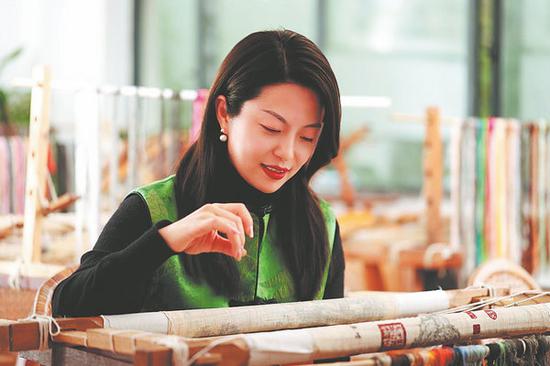 Wu Wanjing, head of the Xiabu Embroidery Art Institute, embroiders a piece of hand-woven fabric at her workshop. (Photo provided to China Daily) Wu Wanjing still remembers her first Xiabu— meaning "cloth for summer" in Chinese — embroidery piece. It was a complete rendition of Dwelling in the Fuchun Mountains, a masterpiece by the famous painter Huang Gongwang during the Yuan Dynasty (1271-1368). The original painting was burned into two parts and preserved separately at the Zhejiang Provincial Museum in Hangzhou and the Palace Museum in Taipei. Reconnecting this artwork with Xiabuembroidery, bridging the two sides across the Taiwan Strait, made the project even more meaningful for her. Wu and her team of embroiderers completed the landscape piece using 37 different types of silk thread, which took almost a year to complete. "In a traditional Chinese landscape painting, the simple but elegant colors are often the hardest to achieve. We had to blend dozens of colors to recreate the shading effects," the 37-year-old explained. "Fortunately, we made it. That work won a gold medal in a competition held by the China National Arts and Crafts Society in 2010." Born in 1987, Wu is the head of the XiabuEmbroidery Art Institute in Xinyu city, Jiangxi province, and a city-level representative inheritor of the national intangible cultural heritage project of Xiabuembroidery. The fabric, made from ramie fibers, is hand-woven through multiple processes. Its unique, cool, and breathable features make it a popular material for summer clothing, hence the name Xiabu. Xinyu is one of its origins. For Wu, Xiabuembroidery is a unique craft. In her eyes, the embroidered works have ancient, elegant colors and a deep, timeless quality. "In the embroidery process, the intersecting lines create a sense of depth and dimensionality, making the image appear both real and unreal, with variations in light and shade. This creates a harmonious unity between the texture of the material and the spatial feel of the objects," she said. In recent years, Wu and her mother-in-law, Zhang Xiaohong, a national-level inheritor of Xiabuembroidery, have focused on nurturing young talent. They have collaborated with women's federations and disability associations at all levels to establish training centers for entrepreneurship and employment. "We offer skills training and job support, creating new opportunities for unemployed women and people with disabilities to generate income. Over the years, we have provided free training to more than 30,000 people, creating more than 2,000 jobs," Wu said. Chen Tianci, born in 1996, is one of the embroiderers. A medical laboratory science graduate, she, like Wu, was drawn into the world of Xiabuembroidery. "Wu guided me into this field. She taught me skills and life lessons and comforted me when I wanted to give up, motivating me to continue. Many people admire Xiabuembroidery, but few are as passionate as she is," said Chen. "Even on business trips, she always finds time to embroider something. It's like that's just something she must do every day." Wu sees the passing on ofXiabu embroidery skills with a developmental perspective. "Transferring intangible cultural heritage essentially involves training more young talent," Wu said. In recent years, Wu has collaborated with universities in Jiangxi, including Nanchang University and Jiangxi Normal University, to establish workshops and teach skills. She has also initiated traditional handicraft study tour projects. In March, Wu was honored as a National March 8 Red-banner Pacesetter, which is a national honor for outstanding women. "Many young people now come to the XiabuEmbroidery Museum in Xinyu for internships and social practices because they are very interested in and love Xiabu embroidery. I hope that more and more young talents will join the ranks of Xiabuembroidery inheritors, bringing new vitality to this ancient craft," Wu said. |
Powered by Discuz! X3.5 Licensed
© 2001-2025 Discuz! Team.